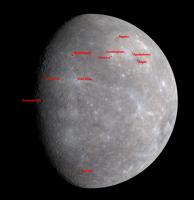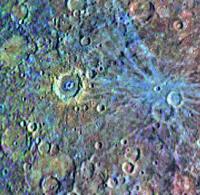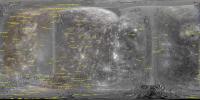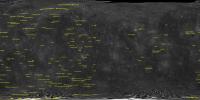Printable Version of Topic
Click here to view this topic in its original format
Unmanned Spaceflight.com _ Mercury _ New Names for Mercury features
Posted by: elakdawalla Apr 10 2008, 05:39 PM
This is just the first of what will presumably be many new sets of names for features on Mercury produced by MESSENGER's imaging:
The following new names have been approved by the IAU for use on Mercury.
Craters: Apollodorus, Atget, Cunningham, Eminescu, Kertész, Neruda, Raditladi, Sander, Sveinsdóttir, Xiao Zhao
Rupes: Beagle Rupes
Fossae: Pantheon Fossae
The newly approved theme for fossae on Mercury is "Significant works of architecture."
Beagle Rupes is the big curvy rupes near the western terminator on the outbound images. Pantheon Fossae is the "spider." Apollodorus is the crater that sits on the spider. Anyone care to try your hand at mapping out the locations of the other craters? They all seem to be on the outbound images, no surprise there.
Name Lat Lon Diameter
Raditladi 27.28 240.93 257
Xiao Zhao 10.64 236.21 23
Atget 25.65 193.93 100
Sander 42.59 205.6 50
Apollodorus 30.58 197.01 41
Sveinsdóttir -2.58 259.96 220
Eminescu 10.79 245.87 125
Cunningham 30.48 203.07 37
Kertész 27.44 214.06 33
Neruda -52.47 234.55 110
--Emily
Posted by: stevesliva Apr 10 2008, 09:46 PM
I was wondering what Jason was talking about with Beagle Rupes. Although with the Mercury theme I expected Beatles Rupes.
Applldorus and Pantheon... nearby?
Posted by: scalbers Apr 17 2008, 05:57 PM
On a somewhat related note, I recently posted some Mercury mapping updates. These include more color imagery from Messenger and earlier radar data from Arecibo Observatory. Details are in the caption...
http://laps.noaa.gov/albers/sos/sos.html#MERCURY
Steve
Posted by: volcanopele Apr 17 2008, 07:35 PM
Here ya go:
Posted by: Phil Stooke Apr 17 2008, 09:13 PM
... and a nice new image on the Messenger site:
http://messenger.jhuapl.edu/gallery/sciencePhotos/pics/EN0108828468M.jpg
Phil
Posted by: nprev Apr 18 2008, 01:08 AM
Wow, I'll say!!! ![]() The central peak complex of that large terraced crater is just wild.
The central peak complex of that large terraced crater is just wild.
Posted by: elakdawalla Apr 21 2008, 05:18 PM
--Emily
Posted by: scalbers Apr 21 2008, 05:32 PM
I believe that is Eminescu - nicely labeled on Jason's new map.
Posted by: jasedm Apr 21 2008, 07:45 PM
And some textbook secondary crater chains - beautiful!
Posted by: Shaka Apr 21 2008, 09:41 PM
I was wondering when somebody would mention those "secondary crater chains". I would like to see the textbook that depicts them. I find it hard to imagine that a series of ejecta blocks from the large crater would land one-after-another along those nearly-perfectly linear tracks, without at least an occasional block landing to one side or the other of the line. That's what I always see in the textbook chains on the Moon or elsewhere, but not here around "Eminescu".
These particular chains are impossibly continuous and co-linear to be formed by flying ejecta blocks. They are primarily radial to Eminescu but not always.
I am prepared to wager that they comprise series of sinkholes formed above linear fractures in an underlying basement rock. The fractures would have formed as a result of the Eminescu impact, but the sinkholes would represent a later modification, as deposited regolith sifted down into the cracks.
I don't think I have ever seen this kind of pattern on the Moon or other planets, and wonder if it is unique here. It implies a pretty remarkable substructure to the Mercurean crust. I can't believe no one else has commented on this. Emily? ![]()
Posted by: Phil Stooke Apr 21 2008, 11:30 PM
Secondary cratering has been understood very well since the pioneering work by Gene Shoemaker in 1960 or so. The curtain of ejecta breaks up into debris strands, not always radial because some are produced by in flight breakup of rotating blocks. We see it around terrestrial explosion craters, lunar craters, Mars craters... and it is better expressed on Mercury because the higher gravity compared with the moon brings the debris down closer to the primary so there's less time for it to spread out and become irregular in appearance. Radial cracks are all but unheard of around impact craters.
Phil
Posted by: jasedm Apr 22 2008, 08:58 AM
Try 'Planetary Geology' by Guest/Butterworth/Murray/O'Donnell 1979 edition Page 22 with 4 photographs on the facing page - very informative.
Posted by: Shaka Apr 22 2008, 09:06 PM
Thanks for the pointer. I'll try to find it. Astonishing is all I can say, that a series of ballistic ejecta trajectories can produce craters like beads on a string. ![]()
Do the hydrocode models of big impacts produce patterns like this?
Incredible.
Posted by: nprev Apr 23 2008, 04:52 AM
The crater chains are odd and cool, but I'm still obsssed with the albedo variations around the central peaks of Eminescu; is the crust much more chemically differentiated then previously thought?
Come to that, some of the crater chain patterns seem to perhaps imply activity post-formation. I wonder how deep beneath the outer crust Mercury's magma might really be? Might be very hard to tell; the place has been slammed continuously since its formation, but it's thick-skinned enough to retain prima facie very ancient impact features. Eminescu doesn't look all that old to me, though, especially in comparison to its presumably associated secondary impact chains.
Posted by: ugordan May 4 2008, 08:23 PM
Here are a couple of false color and natural-ish wide-angle color overlays over the higher resolution NAC image of Eminescu:
http://i108.photobucket.com/albums/n15/ugordan/Eminescu_false_color.jpg http://i108.photobucket.com/albums/n15/ugordan/Eminescu_color_2.jpg
Posted by: edstrick May 4 2008, 10:30 PM
I've uploaded a segment extracted from my enhancement of the departure hemisphere color mosaic
Eminescu is a "middle aged" (sort of equivalent to Eartosthenian, on the Moon) crater with no particularly distinctive color/albedo patterns OTHER than the features surrounding the central peak-ring.
The rim and outer floor of Eminescu are a little "yellower" in the enhancement than most of the surrounding cratered terrain, though the "blue" splattering from the young ray crater to the east, outside the high-rez frame, is an overlay of somewhat masking color-noise. In the general vicinity, crater floor and intercrater plains seem "yellower" than the old crater rims and rugged intercrater terrain, giving the plains a generally neutral color in this enhancement. To the northeast, outside the high-rez frame, some crater walls and patches on the plains have an interesting "pink" color that may be distinctive material (this area was missed by the ejecta). A large degraded crater almost as big as Eminescu, just south of the bright "blue" ray crater, seems to have an unusual "dark blue" central peak, but higher resolution data would be needed to confirm this is real. Another crater in the south part of the enhanced low-rez image has a "pink" central peak, again needing confirmation as a real feature. Patches of a "dark purple-blue" terrain appear near the south east corner of the low-rez frame and extend further south out of the cropped frame and appear to be a patchy regional unit in the rugged highlands there.
But in general, beside near-terminator noise in the color data, the area around Eminescu (within about 3 crater diameters of it's rim) is largely devoid of prominant color variations.
This makes the intense "blue" color of the bright materal in and around the central peaks extremely distinctive. The data suggests also that the dark patches on the crater floor that immediately surround the bright "blue" areas are also strongly "blue" colored. Higher resolution would help confirm this.
A few other craters share this feature: most prominant is the impact basin with a prominent central ring that's to the north of Eminescu. Some of the impact craters within Caloris also have bright, bluish floors and maybe central peaks. One fairly young crater with weak ejecta rays well to the south of Eminescu also has a somewhat bright and blue central peak area. But overall, these features are very uncommon.
"Curiouser and curiouser" said Alice"
Posted by: scalbers Feb 26 2012, 04:18 PM
Here's a map with feature names, some of the new and some of the old ones, using a size threshold of 125km.
Full resolution: http://laps.noaa.gov/albers/sos/features/combined_mercury_lon_zero_center.png
Steve
Posted by: CAP-Team Feb 28 2012, 10:21 PM
Steve, besides adding feature names to your maps, I was wondering if you are working on any updates?
Posted by: Phil Stooke Feb 29 2012, 01:59 PM
http://messenger.jhuapl.edu/gallery/sciencePhotos/image.php?page=2&gallery_id=2&image_id=681
This is the most up to date map from MESSENGER. An updated version might be available in a week with the new PDS release.
Phil
Posted by: scalbers Mar 3 2012, 06:13 PM
CAP-Team, for Mercury a simple idea might be to use the latest MESSENGER map as a background and overlay the global images I've been using that have the lower phase angle? Working directly with 100s of high-resolution images would be a large task for me. Otherwise we can talk about ideas for updating particular maps. Sometimes I can benefit from a little coaching.
For the time being here are the features put on top of the MESSENGER map Phil linked to:
Higher Resolution (4K): http://laps.noaa.gov/albers/sos/features/combined_mercury_messenger_lon_zero_center.png
Steve
Posted by: MarcF May 6 2013, 01:35 PM
Some changes in Mercury nomenclature and new names. Previous Valles became Catenae and valleys (formed due to mechanical and thermal erosion of Mercury's surface by hot, low-viscosity, quickly-flowing lavas) have been named according to the theme of "abandoned cities (and towns and settlements) of antiquity" .
http://messenger.jhuapl.edu/gallery/sciencePhotos/image.php?gallery_id=2&image_id=1161
Regards,
Marc
Posted by: MahFL May 8 2013, 11:59 AM
Regards,
Marc
Unfortuneatly clicking on the "next" for the third image results in an error.
Powered by Invision Power Board (http://www.invisionboard.com)
© Invision Power Services (http://www.invisionpower.com)




